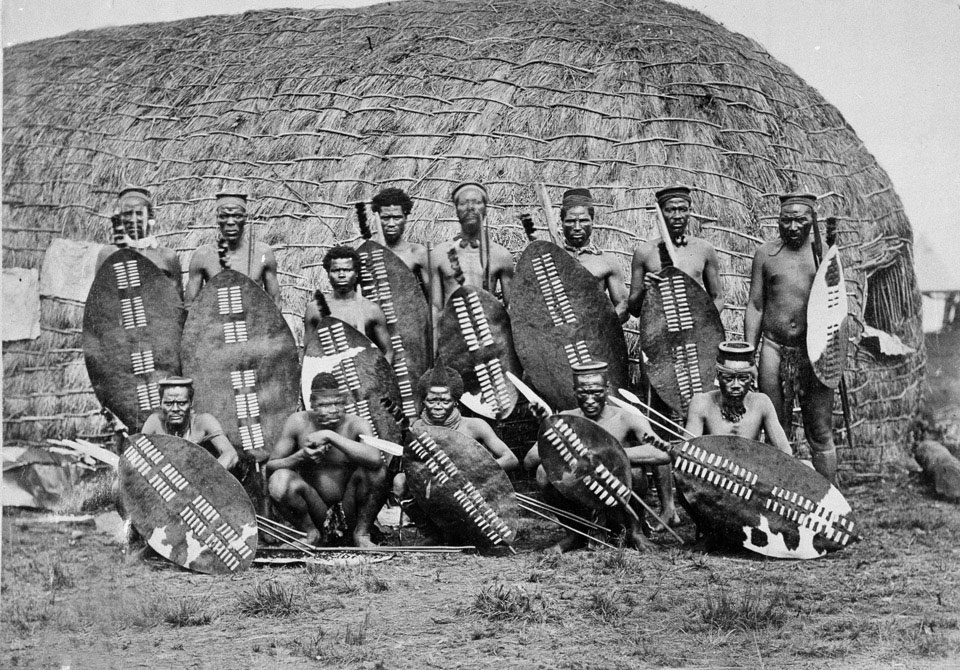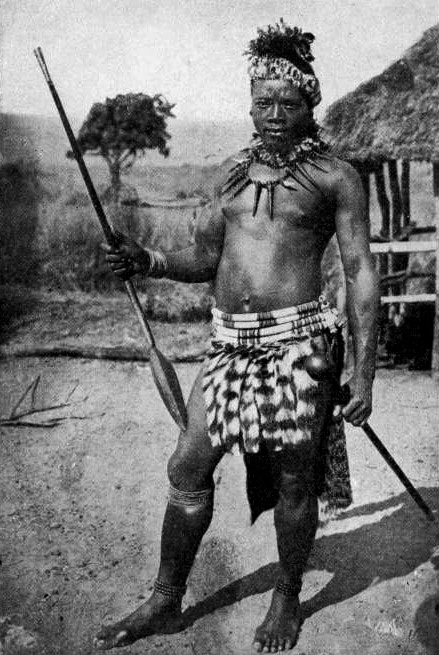|
Battle Of Kambula
The Battle of Kambula took place on 29 March 1879, during the Anglo-Zulu War, when a Zulu military force attacked the British camp at Kambula, having routed the mounted element of the British force at the Battle of Hlobane the day before. The battle was a decisive Zulu defeat and the Zulu warriors lost their belief in victory. The war ended after the Zulu defeat at the Battle of Ulundi on 4 July 1879. Prelude Following the disaster at the Battle of Hlobane on 28 March 1879, the forces of Colonel Evelyn Wood prepared to receive an attack by the entire Zulu impi, of which they had encountered only the leading sections. Soon after dawn of 29 March, Transvaal Rangers rode out to locate the impi, the cattle were put out to graze and after some deliberation, two companies were despatched to collect firewood. By the Rangers had returned with the news that the impi was on the move and was to attack Kambula at noon. Wood also now received information that the impi was nearly 21,000 m ... [...More Info...] [...Related Items...] OR: [Wikipedia] [Google] [Baidu] |
Anglo-Zulu War
The Anglo-Zulu War was fought in 1879 between the British Empire and the Zulu Kingdom. Following the passing of the British North America Act of 1867 forming a federation in Canada, Lord Carnarvon thought that a similar political effort, coupled with military campaigns, might succeed with the African Kingdoms, tribal areas and Boer republics in South Africa. In 1874, Sir Bartle Frere was sent to South Africa as High Commissioner for the British Empire to effect such plans. Among the obstacles were the armed independent states of the South African Republic and the Kingdom of Zululand.Knight (1992, 2002), p. 8. Frere, on his own initiative, sent a provocative ultimatum on 11 December 1878 to the Zulu king Cetshwayo and upon its rejection sent Lord Chelmsford to invade Zululand. The war is notable for several particularly bloody battles, including an opening victory of the Zulu at the Battle of Isandlwana, followed by the defence of Rorke's Drift by a small British force from ... [...More Info...] [...Related Items...] OR: [Wikipedia] [Google] [Baidu] |
Battle Of Kambula Map
A battle is an occurrence of combat in warfare between opposing military units of any number or size. A war usually consists of multiple battles. In general, a battle is a military engagement that is well defined in duration, area, and force commitment. An engagement with only limited commitment between the forces and without decisive results is sometimes called a skirmish. The word "battle" can also be used infrequently to refer to an entire operational campaign, although this usage greatly diverges from its conventional or customary meaning. Generally, the word "battle" is used for such campaigns if referring to a protracted combat encounter in which either one or both of the combatants had the same methods, resources, and strategic objectives throughout the encounter. Some prominent examples of this would be the Battle of the Atlantic, Battle of Britain, and Battle of Stalingrad, all in World War II. Wars and military campaigns are guided by military strategy, wherea ... [...More Info...] [...Related Items...] OR: [Wikipedia] [Google] [Baidu] |
Natal Native Contingent
The Natal Native Contingent was a large force of auxiliary soldiers in British South Africa, forming a substantial portion of the defence forces of the British colony of Natal. The Contingent saw action during the 1879 Anglo-Zulu War. The Natal Mounted Police was created in 1873 to bolster the defenses of Natal. It enlisted European officers, NCOs and natives. The infantry was created in 1878. Most enlisted troops were drawn from the Basuto and Mpondo tribes, which had had long experience fighting the Zulus. Establishment and organisation The Natal legislature established the Natal Mounted Police in 1873 and appointed Major J. G. Dartnell as commander. However, they were slow to appropriate funds for the organization. The first trooper enrolled in March 1874. The first headquarters were at Fort Napier in Pietermaritzburg. The infantry was created in 1878 under Lieutenant-Colonel Anthony William Durnford as part of the Zululand expeditionary force. The structure of the NNC fol ... [...More Info...] [...Related Items...] OR: [Wikipedia] [Google] [Baidu] |
Ulundi
Ulundi, also known as Mahlabathini, is a town in the Zululand District Municipality. At one time the capital of Zulu Kingdom in South Africa and later the capital of the Bantustan of KwaZulu, Ulundi now lies in KwaZulu-Natal Province (of which, from 1994 to 2004, it alternated with Pietermaritzburg as the provincial capital). The town now includes Ulundi Airport, a three-star hotel, and some museums amongst its sights. In the 2001 Census, the population of the town was recorded as 18,420. History When Cetshwayo became king of the Zulus on 1 September 1873, he created, as was customary, a new capital for the nation, naming it "Ulundi" ("The high place"). On 4 July 1879, in the Battle of Ulundi (the final battle of the Anglo-Zulu War), the British Army captured the royal kraal and razed it to the ground. Nearby is Ondini, where King Mpande, Cetshwayo's father, had his kraal. A large Zulu hut now is on the site. Climate Köppen-Geiger climate classification system classifies i ... [...More Info...] [...Related Items...] OR: [Wikipedia] [Google] [Baidu] |
Hlobane
Hlobane is a town in Zululand District Municipality in the KwaZulu-Natal province of South Africa. Coal-mining centre 27 km east of Vryheid and 31 km south-west of Louwsburg. The locality was known as such in the 19th century and the name applied to the town in 1924. Of Zulu origin, it is said by some to mean ‘beautiful place’, and by others ‘place of dispute’. It was the scene of the battle of Hlobane The Battle of Hlobane (28 March 1879) took place at Hlobane, near the modern town of Vryheid in KwaZulu-Natal, South Africa during the Anglo-Zulu War The Anglo-Zulu War was fought in 1879 between the British Empire and the Zulu Kingdo ... in the Zulu War, on 28 March 1879. Bibliography * Ian Knight, Ian Castle, ''Rorke's Drift : Zulu War'', Leo Cooper, UK, 2000. . References External links * Hlobane, Battlefield Populated places in the Abaqulusi Local Municipality Mining communities in South Africa {{KwaZuluNatal-geo-stub ... [...More Info...] [...Related Items...] OR: [Wikipedia] [Google] [Baidu] |
Frontier Light Horse
The Frontier Light Horse, a mounted unit of 200 volunteers, was raised at King William's Town, Eastern Cape Colony in 1877 by Lieutenant Frederick Carrington. It is often referred to as the Cape Frontier Light Horse and served under Brevet Lieutenant-Colonel Henry Burmester Pulleine. Military service The unit served in the 9th Frontier War under Major Redvers Buller. In July 1878 the unit of 276 officers and men marched from King William's Town to Pietermaritzburg and then to Sekhukhuneland for service there. They fought under Captain Robert Johnston Barton in Wood's Column during the Anglo-Zulu War. They acted as rearguard at Hlobane on 28 March 1879 where 20% of the 156 members were lost. Captain Barton, the commanding officer was killed. They then served in the battle of Khambula on the next day and took part in the forward advance of their column into Zululand; present in the battle of Ulundi on 4th July 1879. At the end of that year the unit was disbanded. Victoria Cr ... [...More Info...] [...Related Items...] OR: [Wikipedia] [Google] [Baidu] |
Cecil D'Arcy
Henry Cecil Dudgeon D'Arcy VC (11 August 1850 – 1881) was a New Zealand-born recipient of the Victoria Cross, the highest and most prestigious award for gallantry in the face of the enemy that can be awarded to British and Commonwealth forces. He won the VC on 3 July 1879 at Ulundi in South Africa during the Anglo-Zulu War when he was 28 years old, and a captain in the Frontier Light Horse. Early life D'Arcy was born in Wanganui, New Zealand, where his father Major Oliver Barker D'Arcy (sometimes D'Arcey) of the 65th Regiment was in the British garrison. In 1860, Oliver D'Arcy transferred to the Cape Mounted Riflemen and settled with his family at King William's Town in the Cape Colony. Anglo-Zulu War During the Anglo-Zulu War of 1879, Cecil D'Arcy was an officer in the Frontier Light Horse, a mounted unit of 200 volunteers raised at King William's Town in 1877 by Lieutenant Frederick Carrington. At the Battle of Hlobane on 28 March 1879, his unit acted as the reargua ... [...More Info...] [...Related Items...] OR: [Wikipedia] [Google] [Baidu] |
Assegai
An assegai or assagai (Arabic ''az-zaġāyah'', Berber languages, Berber ''zaġāya'' "spear", French language, Old French ''azagaie'', Spanish ''azagaya'', Italian ''zagaglia'', Middle English ''lancegay'') is a pole weapon used for throwing, usually a light spear or javelin made up of a wooden handle and an iron tip. Area of use The use of various types of the assegai was widespread all over Africa and it was the most common weapon used before the introduction of firearms. The Zulu people, Zulu, Xhosa people, Xhosa and other Nguni people, Nguni tribes of South Africa were renowned for their use of the assegai. ''Iklwa'' Shaka of the Zulu people, Zulu invented a shorter stabbing spear with a two-foot (0.61 m) shaft and a larger, broader blade one foot (0.3 m) long. This weapon is otherwise known as the ''iklwa'' or ''ixwa'', after the sound that was heard as it was withdrawn from the victim's wound. The traditional spear was not abandoned, but was used to ranged we ... [...More Info...] [...Related Items...] OR: [Wikipedia] [Google] [Baidu] |
Killing Zone
In military tactics, the kill zone, also known as killing zone, is an area entirely covered by direct and effective fire, an element of ambush within which an approaching enemy force is trapped and destroyed. The objective of the ambush force is to quickly kill or capture all enemy soldiers inside the kill zone. The trapped soldiers may respond by counterattacking. The term is used in the analogous non-lethal sense in paintball and airsoft tactics. Practice Ambush The kill zone is an element of point ambush in which a military unit targets a single area with offensive fire such as mines, demolitions and section-level weapons. The kill zone may be bordered by obstacles, traps or indirect fire (artillery or mortars) to keep the enemy from escaping. In an area ambush, related multiple kill zones will be covered by multiple kill teams. The weapons of the kill team are not fired until the majority of the enemy unit is within the kill zone, ideally all of the targeted unit. Direct a ... [...More Info...] [...Related Items...] OR: [Wikipedia] [Google] [Baidu] |
Kambula
Kambula, Khambula or ( Zulu Nkambule) is a town located at in the KwaZulu-Natal Province of South Africa. It is the location where the Battle of Kambula was fought in 1879, the result of which was a British Empire victory over the Zulu people Zulu people (; zu, amaZulu) are a Nguni ethnic group native to Southern Africa. The Zulu people are the largest ethnic group and nation in South Africa, with an estimated 10–12 million people, living mainly in the province of KwaZulu-Natal .... References {{Authority control Populated places in the eDumbe Local Municipality ... [...More Info...] [...Related Items...] OR: [Wikipedia] [Google] [Baidu] |







